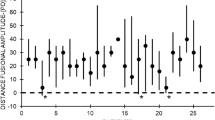Abstract
Purpose
Anisometropia is reported to increase with age; however, the relationship between the development of anisometropia and binocular vision has not been determined. The purpose of this study was to determine the relationship between anisometropia and binocular vision after esotropia (ET) surgery.
Methods
The medical records of 51 consecutive patients with ET who had undergone ET surgery were studied. Patients with amblyopia or anisometropia ≥2 diopters (D) before surgery were excluded. The average age of the patients at the time of surgery was 4.5 ± 3.7 years, and the average postoperative period was 5.0 ± 2.2 years. The refractive errors (spherical equivalent) in both eyes were measured preoperatively and postoperatively. Binocular visual function was evaluated with a modified Worth-4 dot test.
Results
At the final visit, average anisometropia was 0.98 ± 1.30 D, which was significantly greater than the preoperative value of 0.36 ± 0.46 D (P < 0.001). Anisometropia ≥2 D was observed in ten patients (23%) postoperatively. One patient was able to fuse a target of ≥2° (10%) in the anisometropia ≥2 D group, significantly fewer than the 13 patients (32%) in the anisometropia <2.0 D group (P = 0.02).
Conclusions
Anisometropia may develop in patients with poor sensory fusion after surgery for esotropia.
Similar content being viewed by others
References
Cheng CY, Yen MY, Lin HY, Hsia WW, Hsu WM. Association of ocular dominance and anisometropic myopia. Invest Ophthalmol Vis Sci 2004;45:2856–2860.
Hendricks TJW, de Brabander J, Vankan-Hendricks MHP, van der Horst FG, Hendrikse F, Knottnerus JA. Prevalence of habitual refractive errors and anisometropia among Dutch schoolchildren and hospital employees. Acta Ophthalmol 2009;87:538–543.
Qin XJ, Margrain TH, To CH, Bromham N, Guggenheim JA. Anisometropia is independently associated with both spherical and cylindrical ametropia. Invest Ophthalmol Vis Sci 2005;46:4024–4031.
Shih YF, Hsiao CH, Wen SH, Lin LL, Chen CJ, Hung PT. Prevalence of anisometropia in Taiwanese schoolchildren. J Formos Med Assoc 2005;104:412–417.
Fujikado T, Kazuo K, Tano Y. Anisometropia in patients with exotropia [in Japanese]. Jpn J Vis Sci 1993;14:31–34.
Birch EE, Stager DR Sr. Long-term motor and sensory outcomes after early surgery for infantile esotropia. J AAPOS 2006;10:409–413.
Simonsz HJ, Kolling GH, Unnebrink K. Final report of the early vs. late infantile strabismus surgery study (ELISSS), a controlled, prospective, multicenter study. Strabismus 2005;13:169–199.
Fujikado T, Matsuda I, Hosohata J, Ohmi G. A development of a new four-dot test to assess suppression scotoma without glasses. In: Lennerstrand G, editor. Advances in strabismology. Buren, The Netherlands: Aeolus Press; 2000. p. 65–68.
Goss DA, Wickham MG. Retinal-image mediated ocular growth as a mechanism for juvenile onset myopia and for emmetropization. A literature review. Doc Ophthalmol 1995;90:341–375.
Jain S, Arora I, Azar DT. Success of monovision in presbyopes: review of the literature and potential applications to refractive surgery. Surv Ophthalmol 1996;40:491–499.
Brooks SE, Johnson D, Fischer N. Anisometropia and binocularity. Ophthalmology 1996;103:1139–1143.
Author information
Authors and Affiliations
Corresponding author
About this article
Cite this article
Fujikado, T., Morimoto, T. & Shimojyo, H. Development of anisometropia in patients after surgery for esotropia. Jpn J Ophthalmol 54, 589–593 (2010). https://doi.org/10.1007/s10384-010-0868-z
Received:
Accepted:
Published:
Issue Date:
DOI: https://doi.org/10.1007/s10384-010-0868-z




